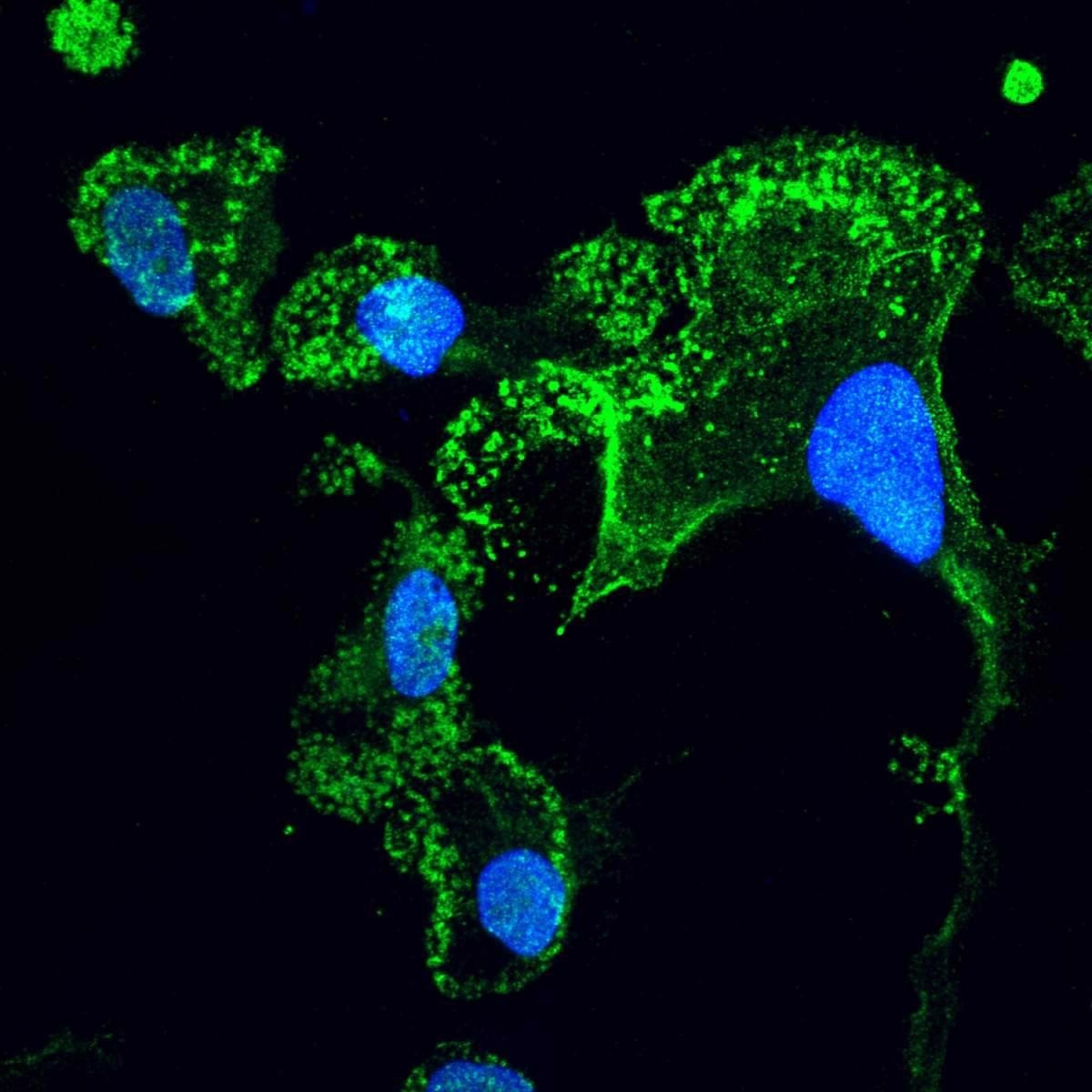When a condition is connected to a genetic mutation, it is generally negative news. Amyotrophic lateral sclerosis, or ALS, is linked to mutations in approximately 25 genes, all of which increase the chance of acquiring this incurable disease.
 Microglia (green) that were “matured” in the lab from stem cells of ALS patients; the cells’ nuclei are in blue. Viewed with confocal microscopy. Image Credit: Weizmann Institute of Science.
Microglia (green) that were “matured” in the lab from stem cells of ALS patients; the cells’ nuclei are in blue. Viewed with confocal microscopy. Image Credit: Weizmann Institute of Science.
A new gene has been connected to ALS by a study team led by Prof. Eran Hornstein of the Weizmann Institute of Science, but this one has mutations of a different kind: they appear to play a defensive, rather than an attacking, function in the disease.
The gene that has recently been linked to ALS is found in what was long referred to be “junk DNA” in the genome. This DNA covers up over 97% of the genome, although it was once dismissed as “junk” since it does not encode proteins.
Even though noncoding DNA is still considered the biological dark matter, it is now known to function as a critical instruction manual. It controls when genes in the coding DNA—those that code for proteins—are switched on and off, among other things.
Hornstein’s group researches neurodegenerative diseases or diseases in which neurons degrade and die, at Weizmann’s Molecular Neuroscience and Molecular Genetics departments. Our noncoding DNA is the focus of the team.
This massive, noncoding part of the genome has been overlooked in the search for the genetic origins of neurodegenerative diseases like ALS. This is despite the fact that for most ALS cases, proteins cannot explain the emergence of the disease.”
Prof. Eran Hornstein, Department of Molecular Genetics and Molecular Neuroscience, Weizmann Institute of Science
Because of the Ice Bucket Challenge, which went viral a few years ago, a lot of people are aware of ALS. Motor neurons, the nerve cells that drive voluntary muscle movement in everything from walking to talking and breathing, are attacked by this unique neurological disease.
The neurons die off over time, resulting in respiratory failure and death. Inflammation in the brain areas related to the dying neurons, mediated by immunological processes in the brain, is one of the signs of ALS.
Dr Chen Eitan, who co-led the study with Aviad Siany at Hornstein’s group, “Our brain has an immune system. If you have a degenerative disease, your brain’s immune cells, called microglia, will try to protect you, attacking the cause of the neurodegeneration.”
The difficulty is that with ALS, the neurodegeneration progresses to the point where persistent microglial activation in the brain reaches hazardous levels. As a result, the immune system causes harm to the brain it was supposed to protect, resulting in the death of additional motor neurons.
That is where the new research was published in Nature Neuroscience. The Weizmann researchers focused on a gene called IL18RAP, which has long been known to impact microglia, and discovered that it can include mutations that reduce the hazardous effects of microglia.
Eitan adds, “We have identified mutations in this gene that reduce inflammation.”
The researchers found that the newly discovered mutations cut the likelihood of acquiring ALS approximately fivefold after studying the genomes of more than 6,000 ALS patients and more than 70,000 persons who do not have ALS.
As a result, these beneficial variants are extremely rare in ALS patients and those who do have them acquire the disease six years later on average than those who do not. In other words, the mutations appear to be connected to a central ALS mechanism, delaying the progression of the illness.
The researchers employed gene-editing techniques to inject protective mutations into stem cells from ALS patients, prompting these cells to grow into microglia in a laboratory dish, confirming their findings. Researchers then cultivated microglia in the same dishes as motor neurons, with or without the protective mutations. Protective mutations in microglia were shown to be less aggressive against motor neurons than in microglia without the mutations.
Motor neurons survived significantly longer when cultured with protective microglia, rather than with regular ones.”
Aviad Siany, Department of Molecular Genetics and Molecular Neuroscience, Weizmann Institute of Science
The findings, according to Eitan, might have consequences for ALS research and beyond.
We’ve found a new neuroprotective pathway. Future studies can check whether modulating this pathway may have a positive effect on patients. On a more general level, our findings indicate that scientists should not ignore noncoding regions of DNA – not just in ALS research, but in studying other diseases with a genetic component as well.”
Dr Chen Eitan, Study Co-Led Author, Department of Molecular Genetics and Molecular Neuroscience, Weizmann Institute of Science
Motor Neuron Survival
A two-part video showing that the survival of motor neurons (green) significantly improved in the presence of microglia harboring the protective mutations (right), compared to microglia without the mutations (left). Video Credit: Weizmann Institute of Science.
Source:
Journal reference:
Eitan, C., et al. (2022) Whole-genome sequencing reveals that variants in the Interleukin 18 Receptor Accessory Protein 3′UTR protect against ALS. Nature Neuroscience. doi.org/10.1038/s41593-022-01040-6.